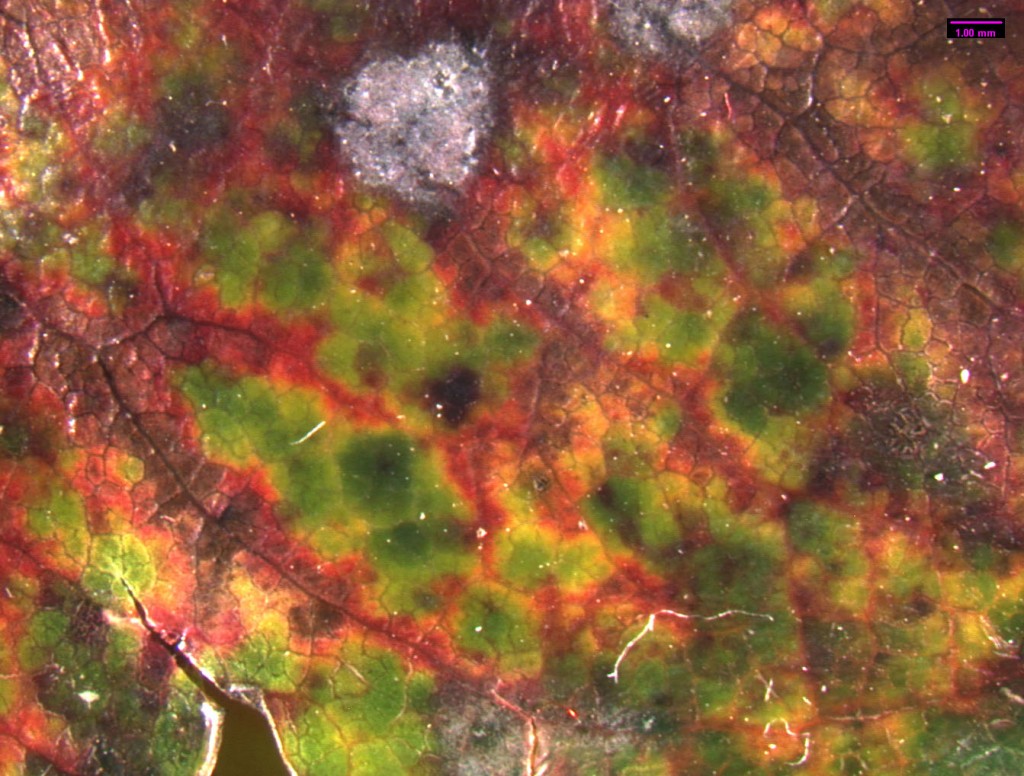Madrone Foliar Pathogens
 Leaves are prime targets for pathogenic fungi, because they have high concentrations of simple sugars. Leaves generally remain on the plant for around 2 years, then they separate when new leaves are forming in the early spring. Madrone is a broadleaf evergreen, and it has many foliar fungi. Foliar pathogens are more successful at colonizing older, aging leaves than new leaves. In Madrone, new foliage is rarely infected until fall (Hunt and Funk 1992). Spores are produced on infected leaves from the previous year or in lesions on the branches. They disperse through wind and rain. Leaf pathogens consist mostly of Ascomycetes of Deutromycetes. Foliage diseases intensify during periods of warm, wet weather. In some years, there is heavy damage to foliage and most is lost. The infected foliage is replaced by new leaves in summer, and the trees look healthier than others around them that may be suffering from summer drought. Coccomyces quadratus and Rhytisma arbuti attack only madrone (Hunt and Funk 1992). They both reproduce by means of sexual spores that are released when wet. The fruiting body of R. arbuti is a speckled tar spot. Early in the season, the fungus produces pycnidia with single celled asexual spores. The infected tissues later become sclerotia. It also forms apothecia with sexual spores that are long and narrow. This fungus is one of the most damaging as it can overwinter on attached foliage. Coccomyces quadratus forms a large tar spot. Most foliar pathogens (including the sexual stage of Fusicoccum aesculi) are Ascomycetes. They all have a similar life cycle. The sexual spores (ascospores) are released from the fruiting body on the leaf. This usually happens during wet weather, particularly in the spring. The ascospores land on another leaf of a suitable host and germinate. They colonize the leaf and form another fruiting body and asexual spores (conidia). In the summer the conidia are dispersed by wind and rain splash, and infecting more leaves. The mycelium continues to produce conidia as long as conditions are favorable, and large quantities are produced in a season. The same mycelium then produces asci, and genetic maerial is exchanged between mycelia of compatible mating types. The ascospores overwinter on dead leaves and begin the cycle again in the spring.
Leaves are prime targets for pathogenic fungi, because they have high concentrations of simple sugars. Leaves generally remain on the plant for around 2 years, then they separate when new leaves are forming in the early spring. Madrone is a broadleaf evergreen, and it has many foliar fungi. Foliar pathogens are more successful at colonizing older, aging leaves than new leaves. In Madrone, new foliage is rarely infected until fall (Hunt and Funk 1992). Spores are produced on infected leaves from the previous year or in lesions on the branches. They disperse through wind and rain. Leaf pathogens consist mostly of Ascomycetes of Deutromycetes. Foliage diseases intensify during periods of warm, wet weather. In some years, there is heavy damage to foliage and most is lost. The infected foliage is replaced by new leaves in summer, and the trees look healthier than others around them that may be suffering from summer drought. Coccomyces quadratus and Rhytisma arbuti attack only madrone (Hunt and Funk 1992). They both reproduce by means of sexual spores that are released when wet. The fruiting body of R. arbuti is a speckled tar spot. Early in the season, the fungus produces pycnidia with single celled asexual spores. The infected tissues later become sclerotia. It also forms apothecia with sexual spores that are long and narrow. This fungus is one of the most damaging as it can overwinter on attached foliage. Coccomyces quadratus forms a large tar spot. Most foliar pathogens (including the sexual stage of Fusicoccum aesculi) are Ascomycetes. They all have a similar life cycle. The sexual spores (ascospores) are released from the fruiting body on the leaf. This usually happens during wet weather, particularly in the spring. The ascospores land on another leaf of a suitable host and germinate. They colonize the leaf and form another fruiting body and asexual spores (conidia). In the summer the conidia are dispersed by wind and rain splash, and infecting more leaves. The mycelium continues to produce conidia as long as conditions are favorable, and large quantities are produced in a season. The same mycelium then produces asci, and genetic maerial is exchanged between mycelia of compatible mating types. The ascospores overwinter on dead leaves and begin the cycle again in the spring.
Didymosporium arbuticola and Diplogia maculata are asexual fungi found only on madrone. Their fruiting bodies are small leaf spots. Didymosporium arbuticola forms brown spots 3-6 mm in diameter with purple to reddish margins (Hepting 1971). Blister blight (exobasidium vaccinii) forms pinkish blister-like galls that twist and distort leaves. It attacks the fruit, making it turn red and swell to several time its natural size. Basidiospores are formed on the underside of the leaf blisters and on the surface of the infected fruits in a thin layer of fungal tissue. They are ejected during wet weather. Foliage diseases rarely threaten the survival of the tree; however, persistent foliage disease may predispose trees to attack by other fungi. Inoculum can be reduced by removing dead leaves and pruning infected twigs. Unraked leaves are a source of inoculum in the late summer or early fall. Splashing the foliage when watering will spread spores.
Madrone foliar pathogens info found @
http://soilslab.cfr.washington.edu/madrone/ch07_el.pdf
Marianne, Elliot. Diseases of Pacific Madrone.
Citations
Hepting, G.H. 1971. Diseases of Forest and Shade Trees of the UnitedStates. USDA Forest Service. Handbook #386:76–78.
Hunt, R.S, and A. Funk. 1992. Common Pests of Arbutus. Canadian
Forestry Service, Victoria, British Columbia. FPL 63.
Leave a Reply